Contents
Due to its high yield and strong immunity, the Dutch onion is popular with gardeners and vegetable growers. All varieties are undemanding, with conventional agricultural practices, rarely get sick. The culture is grown on a feather, consumed fresh, used for winter harvesting. Planting material comes to Our Country from the Netherlands. It undergoes strict fractional calibration on special equipment.
Advantages and disadvantages
Holland is rightfully considered a leader in terms of breeding and supplying onion sets to the seed market. The culture is represented by a variety of varieties of early, middle and late ripening. Planting material can be purchased at any specialized store. A certified product guarantees a harvest corresponding to the varietal characteristics.
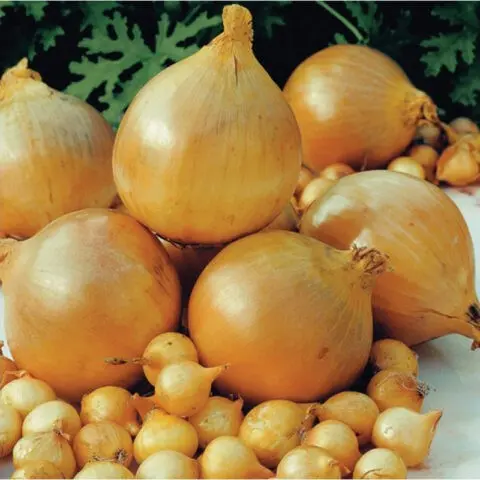
The onion of the Dutch selection is popular, it is widely cultivated on an industrial scale.
Pros:
- variety of varieties (by maturity);
- you can choose for every taste (spicy or sweet), all vegetables are characterized by high nutritional value;
- stable yield;
- the possibility of mechanized cleaning;
- suitable for planting in spring and before winter;
- frost resistance allows you to grow a crop in a cold climate;
- versatility in use;
- the plant is stress-resistant, calmly reacts to weather changes;
- good immunity, seedlings practically do not get sick, they are rarely affected by pests;
- increased percentage of germination (95-98%);
- no tendency to bloom and shoot;
- the crop tolerates transportation, retains its presentation for a long time;
- does not require special agricultural technology.
Cons:
- you can not get planting material yourself.
Description and photos of the best varieties of Dutch onions
When choosing a Dutch onion, the time of planting is taken into account – in spring or autumn, in what way they will be cultivated – open or in a greenhouse. Be sure to find out if it is suitable for the weather conditions of the region. The names and descriptions of the most popular winter varieties of Dutch onion sets are presented below.
Radar
Radar is a salad, sweet Dutch variety that has been on the seed market for over 20 years. Mid-season, suitable for any planting time. Cold-resistant, with a stable yield: from 1m2 take up to 7 kg. Cultivation is possible in all regions, except for the Far North, where Dutch onions are planted in greenhouses. The radar is universal in use.
What it looks like:
- plant height – 35 cm;
- leaves are tubular, numerous, dark green, glossy;
- the shape of the onion is round, slightly compressed from below and above, weighing 150-200 g;
- the upper membranous structure is hard, dark yellow, the inner is juicy, white with a greenish tinge;
- the neck is short, thin.
The shelf life of the Dutch harvest is up to eight months.
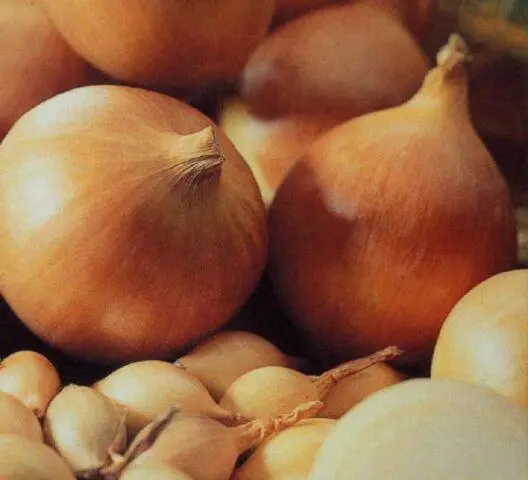
The radar is not prone to shooting
Shakespeare
Shakespeare is a Dutch onion variety that was bred specifically for planting before winter. Culture of early ripening. In a warm climate, the crop is harvested at the end of May, in a temperate climate – in mid-June. The taste is semi-sweet, the Dutch variety is intended for fresh use, does not lie for a long time. As an option for harvesting for the future is not suitable.
The Dutch Shakespeare onion is grown commercially for sale. Heads of medium weight – 100-110 g, dense. The scales are hard, golden, the inner layers are juicy, white with a bluish tint. Does not give arrows, goes to the pen. Productivity from 1 m² – 5-6 kg.
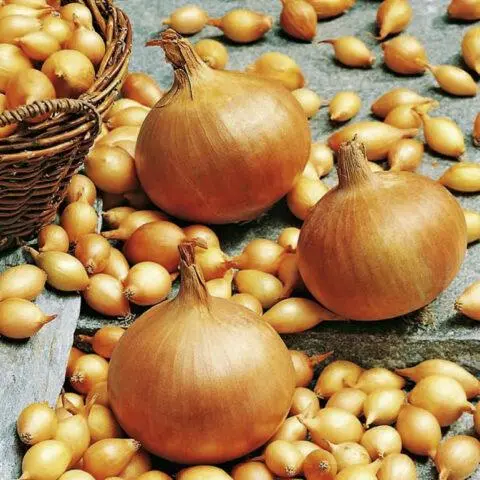
Cold-resistant Shakespeare, does not get sick, feels comfortable in the Siberian and Ural regions
Centurion
Centurion is a Dutch mid-early onion that matures in three months. Suitable for winter planting in the subtropical zone. In the Central, Middle lane and continental temperate climates, they are sown only in spring. Yield indicator – 4,5-5 kg per 1 m2fruiting is stable. The Dutch variety is not afraid of a sharp drop in temperature and drought. May be affected by powdery mildew in the rainy season. To other infections characteristic of the culture, the onion is resistant.
Characteristic:
- leaves 25-30 cm high, not numerous, with a rigid structure, go to the feather only at the beginning of growth;
- the bulb is broadly ovoid, weight – 100-150 g;
- scales tightly pressed, dark brown;
- the inside is juicy, spicy, white;
- the neck is thick and long.
Grown in household plots and farm fields.
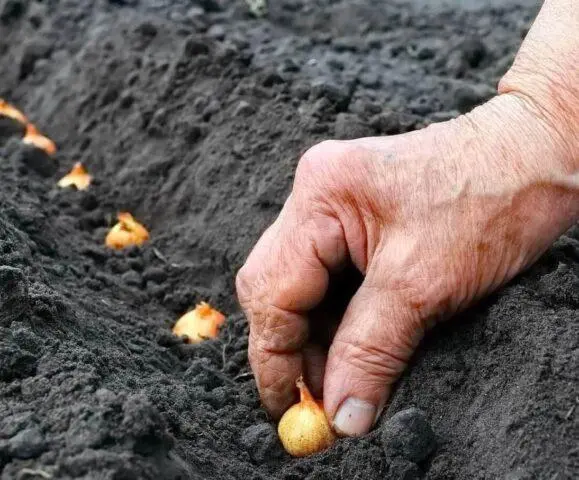
Centurion after harvest does not lose nutritional value and presentation for 10 months
Hercules
Hercules is a medium early variety. If planted before winter, it ripens in 2,5 months. Frost-resistant, stress-resistant, not afraid of the cold and hot season. Productivity is high: from 1m2 take up to 10 kg of vegetables. Hercules is the leader in this parameter among other varieties of Dutch selection.
The taste is slightly spicy, with a pronounced smell. The structure of the leaves is delicate, goes to the pen. It grows up to 30 cm. Oval turnip – weight 150-200 g. The internal structure is dense, juicy. The neck is thin and short. The variety does not get sick, it is not affected by pests.
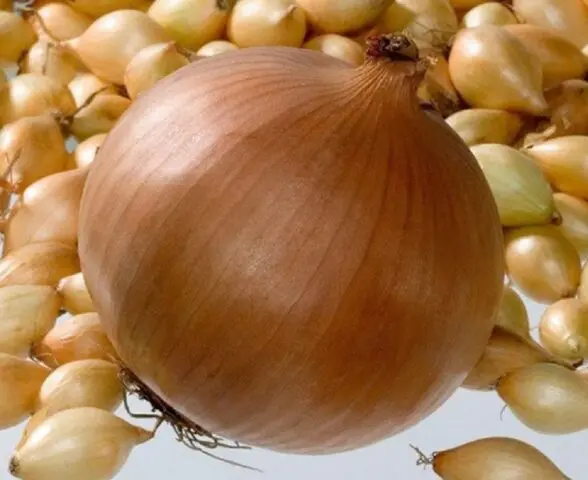
Hercules is a table variety that is suitable for all culinary recipes and fresh vegetable salads.
Sturon
Sturon is a variety created on the basis of the popular Dutch onion Stuttgarter Riesen. This is an improved form in terms of frost resistance, resistance to infections. Grows in cold and warm climates. The species is common in Siberia and the Urals. Sturon is planted before winter and spring.
Characteristic:
- leaf height – 35 cm, dark green feather, with a wax coating, rigid structure;
- the bulb is oval, weight – 180-200 g;
- scales light brown with longitudinal stripes;
- the taste is spicy, the purpose is table, the inner layers are dense. Vegetable juicy, white.
Transportability is good. Shelf life – up to eight months.
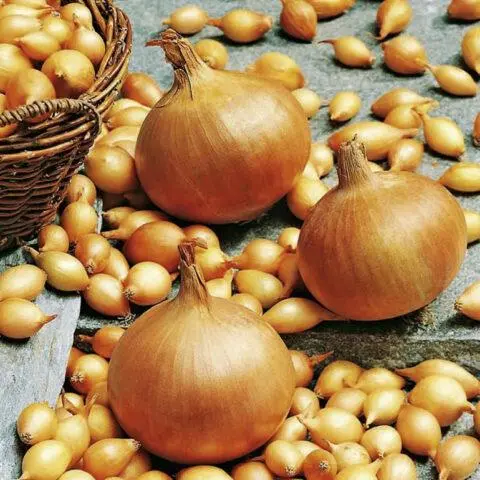
Sturon onion is medium late, ripens in 120 days
Red baron
Mid-early lettuce variety with a pleasant taste and mild odor. Quite popular in Our Country. In 1998, it was entered into the State Register. The use is universal, they are consumed fresh, grown on a feather, included in all culinary recipes. Cultivated on an industrial scale and on private plots in all climatic zones (except for the territory of risky farming).
Planted in the south before winter, in colder regions – in the spring. The bulbs are rounded, their weight is 90-100 g. The scales are bright burgundy with a purple tint. The internal structure is pink, with red fragments, juicy, semi-sharp. Shelf life – 10 months.
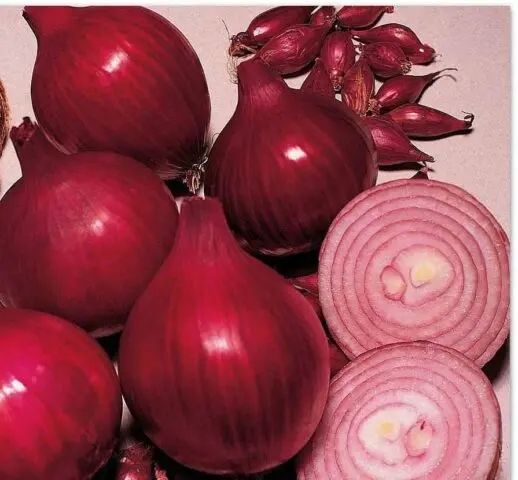
The yield of the Dutch onion Red Baron is from 5 to 7 kg per 1 m2
How to plant Dutch onion sets
All varieties are grown as annuals. Holland supplies only hybrid forms of the crop, they rarely produce seeds. Even if you managed to collect and sow them, the result will be unpredictable. Growing vegetables with the characteristics of the parent plant will not work.
When to plant Dutch onions
Sowing is carried out in spring or late autumn. At the beginning of the season, you can start work when the soil warms up to +12 0C. For a warm climate – approximately in mid-April, in the temperate zone – in early May. Sow at this time mid-season or late varieties. Sevok is used large, with a diameter of 1,5-2,5 cm.
For planting before winter, early or medium varieties of Dutch onions are chosen. If the seedlings are of different sizes, they are sorted and small specimens up to 1 cm in diameter are determined on a bed. Such material will not be preserved until the beginning of the growing season, it will become dry and lose its germination capacity. Work is carried out in the second half of October.
Site selection and soil preparation
The Dutch bow is picky about light. It develops poorly in the shade, the green mass becomes thin, elongated, pale, the turnip becomes small, loose. Under the culture allocate an open sunny area. The place must be dry, the soil fertile, with a neutral reaction.
For spring planting, the garden bed is prepared in the fall:
- Remove all plant debris, dig.
- Spray the surface with copper sulfate.
- Water well before frost.
- In winter, snow is dumped from the site so that the soil freezes as much as possible and the wintering pests die.
In April, the bed is loosened, raised by about 20 cm, compost, peat, urea and superphosphate are added.
If the Dutch onion is planted in October:
- The place is dug up, weeds are removed by the roots.
- Disinfect with Hom (copper oxychloride).
- Peat, humus, perphosphate, potassium sulfate, wood ash are buried in the soil.
After sowing, the site is covered with sawdust or peat with a layer of 3-5 cm so that the Dutch onion does not freeze. In the spring, the mulch is removed for better germination.
Preparation of planting material
Before sowing, sort, discard weak, dry bulbs. As a rule, there is very little illiquid material. Onions of Dutch selection are of good quality, practically no waste. Sevok is heated for 8-10 hours at a temperature of +400C. Cut the onion to the shoulders, and lower it into the Energen solution for better germination.
Landing scheme
Bed marking:
- At a distance of 25 cm, longitudinal furrows are made with a depth of 4 cm.
- Watered with warm water.
- Onions are distributed at a distance of 8 cm.
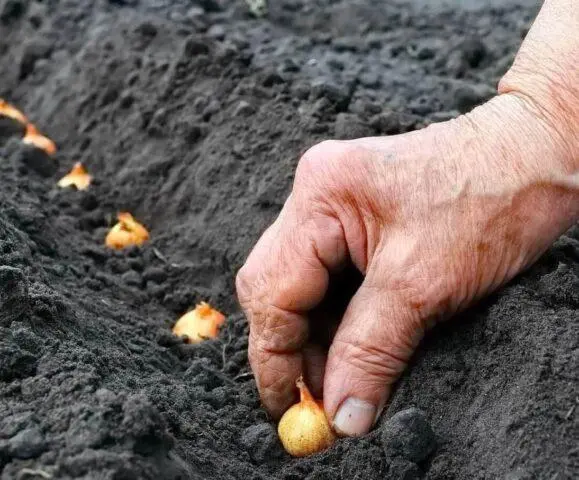
Placed in the ground upside down
They cover it so that there is a substrate layer no higher than 2,5 cm above the shoulders. With deep planting, the ripening of the Dutch onion will be delayed, and the turnip will be deformed. With a slight immersion in the ground, the material will be exposed, growth will stop, in hot weather, the set may dry out and not sprout.
Care instructions
After the appearance of sprouts, look at the density of planting. If necessary, it is thinned out to withstand at least 10 cm between the nests.
Growing Dutch onions:
- In the absence of precipitation in the first 2,5 months, 6-8 liters of water are watered every week under the root. Soil moistening is stopped three weeks before harvest.
- Weed a bed with Dutch onions as weeds appear.
- When the leaves grow up to 15 cm long, make a solution of copper oxychloride and spray the tops.
- They feed the Dutch onion in the stage of the Energen loop. After 10 days, potassium sulfate and urea are added. At the time of the formation of the heads, the Dutch vegetable is fertilized with organic matter, after two weeks Agricola for onions and garlic is added by sprinkling.
14 days before harvesting, all top dressing is stopped.
Conclusion
Dutch onion is a cold-resistant species with strong immunity. It can be grown in any climate zone outdoors or indoors. Most of the varieties are suitable for autumn planting both in the south and in temperate climates. Onions are characterized by high nutritional value, stable fruiting. The fruits are transportable, universal in use, and stored for a long time.









